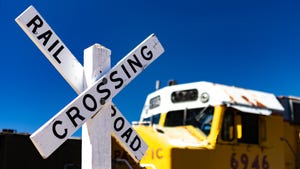
Huge Historic Locomotives and More at the Western Pacific Railroad Museum - CNET
The Western Pacific Railroad Museum features dozens of historic locomotives, coaches, cabooses and more. Keep scrolling for the full tour.

Starting at one end of the facility, this dazzling paint job covers one of the huge snow plows utilized to clear tracks in the Sierra Nevadas. It’s built onto a former 12,000-gallon steam locomotive tender.

The colors of these switcher locomotives and caboose look even more vibrant in person.

I’m in awe at the size of this lad. Absolute unit.

It’s an EMD DD40X, one of the most powerful single-chassis locomotives ever made, and one of the largest as well. They were only used by Union Pacific.

The spacious cab of the DDA40X, which were nicknamed “Centennials” by UP.

Only 47 Centennials were built. They had a top speed of 90mph.

Nearly 100 feet long, the DDA40Xs housed two, 3,300-horsepower V16 engines. They were all retired in the mid ’80s.

This G50 railcar was first used by the USAF as a kitchen car, and was later converted to a guard car for the Strategic Air Command. (SAC has its own excellent museum.)

Here we see a cluster of colored cabooses.

In the background is the museum’s train shed. In the foreground, an EMD GP9 from 1955. It was in service with the Western Pacific, and then Union Pacific after the merger. It has the latter’s livery.

The museum’s other AS-616. Both were built in 1952 and were powerful locomotives in their day.

You’d never know this engine was over 70 years old, thanks to a careful restoration and new paint.

The 1503 is an EMD SW1500, the last one built for Western Pacific. It enjoyed a long life for Union Pacific throughout the southwest before finding its way back here. It was repainted in WP livery.

Though looking quite new with its fresh black paint, this is an EMC (later EMD) SW-1, Western Pacific’s first diesel electric locomotive. It has a 600hp two-stroke V6 and was built in 1939.

One of several California Zephyr railcars the museum is collecting and looking to restore. This is the “Silver Lodge” a Budd Vista Dome Coach.

This is a Union Pacific Business-Observation Car, built by Pullman in 1917. You can go inside, and it’s quite the time capsule.

It was first used as the personal coach for the president of Union Pacific. Cameo by me.

The interior was updated several times, with most of its current aesthetic dating from 1965.

The dining room. The coach was finally retired from service in 1986, which is an impressive run for any machine.

I kid you not, my dad had this exact stereo receiver when I was growing up.

Originally the kitchen had a wood-burning stove. That’s how old this coach is. It was later fitted with a propane stove.

This shiny yellow caboose is a UP Class CA-5, built by Union Pacific itself. Many of the cabooses at the museum are open to explore. So I did.

I love exploring cabooses because they’re so iconic from the outside, but you so rarely get to see inside. They’re basically office lounges for railway employees.

Office lounges with a view, that is.

A different design for this caboose built in 1941 and used by the Denver and Rio Grande Western Railroad.

Features found inside most cabooses are benches, the cupola and usually a stove for heat.

The chair can face either direction.

In the middle is another GP7, also from 1952. She’s the sister locomotive to the green one we saw earlier. It still runs, though is currently undergoing maintenance.

On the left is the Southern Pacific Rotary MW208 snowplow, similar to the one found at the Colorado Railroad Museum I toured last year. On the right, an EMD FP7.

The FP7 is, to me anyway, such an iconic diesel locomotive design. This one actually pulled the California Zephyr through California, Nevada, and Utah for 20 years.

This is an EMD F7, one of two at the museum. It was built in 1950 and produced 1,500 horsepower from its V16 engine.

Just a bit of razor burn. That will buff out.

These are “booster” units for the F7s, called F9Bu. They have an additional 1,250 horsepower from a supercharged V16 diesel.

This another EMD GP7, though from a separate order in 1953 than the others. It served with the WP subsidiary Sacramento Northern until all were merged with Union Pacific in the ’70s.

WP had some great livery colors, and this S-4 has seen them all. One of the only switcher locomotives to have been painted in all of WP’s liveries over its decades of service.

All museums have limited time and money, so not everything will get the full restoration treatment. This is the first Alco diesel-electric purchased by WP and was built in 1941.

The Western Pacific Railroad Museum is only open for roughly half the year, the warmer half. During those months, it’s typically only open Thursday through Sunday.
For more about the museum and our tour, check out Rails to the Past: Exploring the Western Pacific Railroad Museum.



